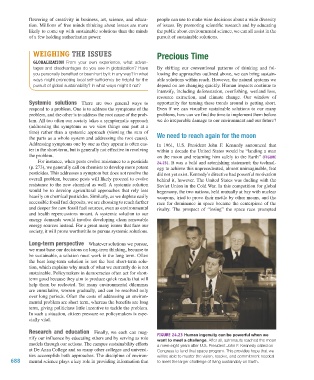Page 689 - Environment: The Science Behind the Stories
P. 689
flowering of creativity in business, art, science, and educa- people can use to make wise decisions about a wide diversity
tion. Millions of free minds thinking about issues are more of issues. By promoting scientific research and by educating
likely to come up with sustainable solutions than the minds the public about environmental science, we can all assist in the
of a few holding authoritarian power. pursuit of sustainable solutions.
WeIGHING tHe ISSUeS Precious Time
GlobalIzatIoN From your own experience, what advan-
tages and disadvantages do you see in globalization? Have By shifting our conventional patterns of thinking and fol-
you personally benefited or been hurt by it in any way? In what lowing the approaches outlined above, we can bring sustain-
ways might promoting local self-sufficiency be helpful for the able solutions within reach. However, the natural systems we
pursuit of global sustainability? In what ways might it not? depend on are changing quickly. Human impacts continue to
intensify, including deforestation, overfishing, wetland loss,
resource extraction, and climate change. Our window of
Systemic solutions There are two general ways to opportunity for turning these trends around is getting short.
respond to a problem. One is to address the symptoms of the Even if we can visualize sustainable solutions to our many
problem, and the other is to address the root cause of the prob- problems, how can we find the time to implement them before
lem. All too often our society takes a symptomatic approach we do irreparable damage to our environment and our future?
(addressing the symptoms as we view things one part at a
time) rather than a systemic approach (viewing the sum of
the parts as a whole system and addressing the root cause). We need to reach again for the moon
Addressing symptoms one by one as they appear is often eas- In 1961, U.S. President John F. Kennedy announced that
ier in the short-term, but is generally not effective in resolving within a decade the United States would be “landing a man
the problem. on the moon and returning him safely to the Earth” (Figure
For instance, when pests evolve resistance to a pesticide 24.23). It was a bold and astonishing statement; the technol-
(p. 273), we generally call on chemists to develop more potent ogy to achieve this unprecedented, almost unimaginable, feat
pesticides. This addresses a symptom but does not resolve the did not yet exist. Kennedy’s directive had powerful motivation
overall problem, because pests will likely proceed to evolve behind it, however. The United States was dueling with the
resistance to the new chemical as well. A systemic solution Soviet Union in the Cold War. In this competition for global
would be to develop agricultural approaches that rely less hegemony, the two nations, held mutually at bay with nuclear
heavily on chemical pesticides. Similarly, as we deplete easily weapons, tried to prove their mettle by other means, and the
accessible fossil fuel deposits, we are choosing to reach farther race for dominance in space became the centerpiece of the
and deeper for new fossil fuel sources, even as environmental rivalry. The prospect of “losing” the space race prompted
and health repercussions mount. A systemic solution to our
energy demands would involve developing clean renewable
energy sources instead. For a great many issues that face our
society, it will prove worthwhile to pursue systemic solutions.
Long-term perspective Whatever solutions we pursue,
we must base our decisions on long-term thinking, because to
be sustainable, a solution must work in the long term. Often
the best long-term solution is not the best short-term solu-
tion, which explains why much of what we currently do is not
sustainable. Policymakers in democracies often act for short-
term good because they aim to produce quick results that will
help them be reelected. Yet many environmental dilemmas
are cumulative, worsen gradually, and can be resolved only
over long periods. Often the costs of addressing an environ-
mental problem are short term, whereas the benefits are long
term, giving politicians little incentive to tackle the problem.
In such a situation, citizen pressure on policymakers is espe-
cially vital.
Research and education Finally, we each can mag- Figure 24.23 Human ingenuity can be powerful when we
nify our influence by educating others and by serving as role want to meet a challenge. After all, astronauts reached the moon
models through our actions. The campus sustainability efforts a mere eight years after U.S. President John F. Kennedy called on
at De Anza College and so many other colleges and universi- Congress to fund that space program. This provides hope that we
ties accomplish both approaches. The discipline of environ- will be able to muster the vision, resolve, and commitment needed
688 mental science plays a key role in providing information that to meet the larger challenge of living sustainably on Earth.
M24_WITH7428_05_SE_C24.indd 688 13/12/14 10:40 AM

